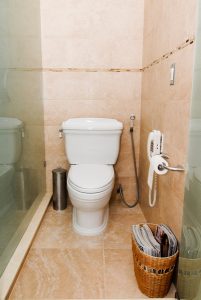If you’ve ever experienced the annoyance of a running toilet, you know how it can quickly become a frustrating and costly plumbing issue. A toilet that doesn’t stop running wastes water and increases your utility bills. Luckily, many running toilet issues are fixable with simple troubleshooting steps. But when the problem persists, it’s time to call the expert plumbers in Panama City—the Peaden Pros.
Why Is My Toilet Running?
A running toilet occurs when water continuously flows from the tank into the bowl, even when the toilet is not in use. This is often caused by:
- Faulty Flapper: The flapper is the rubber seal that covers the flush valve. If it’s worn out, warped, or misaligned, it can allow water to leak into the bowl.
- Chain Issues: If the chain connecting the flush lever to the flapper is too tight or too loose, it can cause the flapper to stay open or not seal properly.
- Float Problems: The float controls the water level in the tank. A float set too high can cause water to spill into the overflow tube, while a float set too low may prevent the tank from filling completely.
- Worn-Out Fill Valve: The fill valve controls how much water refills the tank after each flush. A damaged or malfunctioning fill valve can lead to constant water flow.
- Sediment Build-Up: Over time, mineral deposits can accumulate in the tank’s components, reducing their efficiency and causing leaks.
Steps to Fix a Running Toilet
Before you call in the Peaden Pros, there are a few steps you can take to try and resolve the issue yourself:
1. Inspect the Flapper
Turn off the water supply to the toilet. Remove the tank lid and check the flapper for signs of wear or damage. If it’s misaligned, adjust it to ensure a proper seal. If it’s worn, replace it with a new flapper from your local hardware store.
2. Adjust the Chain
Ensure the chain has the right amount of slack—about 1/2 inch. If it’s too short, it can prevent the flapper from closing. If it’s too long, it may get tangled.
3. Check and Adjust the Float
If your toilet has a ball float, bend the arm downward slightly to lower the water level. For a cylinder float, adjust the clip or screw to set the water level about 1 inch below the top of the overflow tube.
4. Clean the Tank Components
Use a soft brush and vinegar solution to clean any sediment or mineral buildup. This can improve the performance of the flapper and fill valve.
5. Inspect the Fill Valve
If the fill valve is old or damaged, it’s often easier to replace it than attempt a repair. Follow the manufacturer’s instructions to install a new fill valve.
When to Call the Peaden Pros
While some running toilet issues can be resolved with DIY efforts, others require the expertise of a professional. Here’s when you should contact Peaden:
- Persistent Leaks: If your toilet continues to run despite your best efforts, there may be an underlying issue, such as a cracked flush valve or a hidden leak.
- Complicated Repairs: Replacing internal components like the flush valve or repairing the overflow tube can be tricky without the right tools and experience.
- Water Damage Concerns: A running toilet can lead to water damage in your bathroom if left unchecked. Don’t wait until the problem worsens.
- High Water Bills: If you notice a significant spike in your water bill, it’s time to let a professional diagnose and fix the issue.

